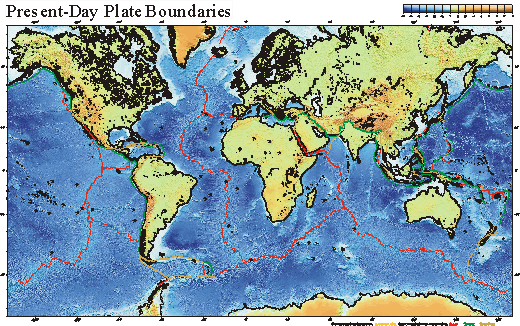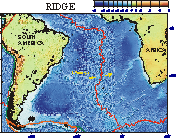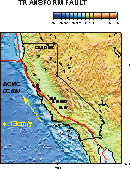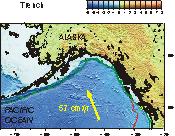A General, Brief Overview of Plate Tectonics.

(Click here to see larger (>8.6Mbytes!) version of above map.)
This page is a only a brief overview of the study of plate tectonics. There are other websites that provide more indepth discussions of the field as well as numerous references, some of which are listed below.
The upper part of the earth's crust is broken into units called plates. A tectonic plate may be described as a segment of the Earth's lithosphere (uppermost 100km of the rigid shell) that moves independently of other regions. Today there are seven major plates: North America, South America, Eurasia, Africa, India, the Pacific, and Antarctica. There is geophysical evidence that the Indian plate may actually be two plates, with north-south compression occurring in the Indian Ocean just south of India. Besides the major plates, there are numerous microplates such as the Philippine Plate in the western Pacific Ocean and the Juan de Fuca Plate in the northeastern Pacific Ocean to the west of the state of Washington. The number and the shape of the plates have changed through time, with some plates being destroyed at subduction zones and other plates, carrying low-density continents, colliding to form 'supercontintents.' The most recent 'supercontinent' was Pangea. The 'supercontinents' have all subsequently fragmented to form today's continents.

 The plates are divided by seismically-active boundaries. The type of boundary depends on the motion occurring between the plates at that location. In the ocean basins are spreading ridges (similar to underwater mountains in size and shape). At the spreading ridges
(such as the one in the Atlantic Ocean between the North American and African plates), basalt from the earth's mantle wells upwards to the surface of the earth to form new oceanic crust. The plates move away from each other as new oceanic crust is created. At transform fault boundaries (such as the San Andreas Fault in California which divides the Pacific and North American plates), the plates move or slide horizontally past each other.
At subduction zone boundaries (such as the Aleutian Trench between Alaska and the Pacific Plate), the plates move towards each other, with one plate subducting or moving beneath the other as the earth's lithosphere is recycled into the mantle.
The plates are divided by seismically-active boundaries. The type of boundary depends on the motion occurring between the plates at that location. In the ocean basins are spreading ridges (similar to underwater mountains in size and shape). At the spreading ridges
(such as the one in the Atlantic Ocean between the North American and African plates), basalt from the earth's mantle wells upwards to the surface of the earth to form new oceanic crust. The plates move away from each other as new oceanic crust is created. At transform fault boundaries (such as the San Andreas Fault in California which divides the Pacific and North American plates), the plates move or slide horizontally past each other.
At subduction zone boundaries (such as the Aleutian Trench between Alaska and the Pacific Plate), the plates move towards each other, with one plate subducting or moving beneath the other as the earth's lithosphere is recycled into the mantle.

Hotspots are places where molten rock from the earth's mantle is erupting at the surface. Hawaii and Iceland are hotspots. Some scientists think the hotspots move relative to the earth. Other scientists think the hotspots are fixed to the earth. Hotspots leave their marks on the plates as the plates move across them. If you look at Hawaii, you'll notice a linear feature (the Hawaii-Emperor seamount chain) on the Pacific plate. This feature was made by the Hawaiian hotspot as the Pacific plate moved over it. In the northwest Pacific you can see a whole series of seamount chains that were formed by hotspots. Hotspots can also create large igneous provinces, such as the Ontong Java Plateau (northeast of Australia) and the Kerguellen Plateau (in the southern Indian Ocean).
There are various theories on what the driving forces are for plate tectonics, including 'slab pull' and the hotspot theories. Slab pull is the theory in which subduction of the earth's crust is thought to pull the plates apart. One hotspot theory states that the supercontinents move over top of a hotspot that heats the crust, causing it to uplift, thin, and eventually pull apart. Another theory states that the thinning of the crust occurs first and then the hotspot forms.
A Powerpoint animation is available presenting a very brief overview of the history of plate tectonics along with some key references.
A few references on plate tectonics.
Kious, W.J. and Tilling, R.I., 1994, This Dynamic Earth: The Story of Plate Tectonics,
published by the U.S. Geological Survey, Washington, D.C., 77 p.
(http://pubs.usgs.gov/publications/text/dynamic.html).
Condie, Kent C., 1997, Plate Tectonics and Crustal Evolution, published by Butterworth Heinemann, Boston.
Erikson, J., 1992, Plate Tectonics: Unraveling the Mysteries of the Earth, published by Facts on File, New York, 197 p.
Seyfert, Carl K., 1987, The Encyclopedia of Structural Geology and Plate Tectonics, published by Van Nostrand Reinhold, New York, 876 p.
Simkin, Tom, et al., 1994, This Dynamic Planet: World Map of Volcanoes, Earthquakes, Impact Craters, and Plate Tectonic, published by the U.S. Geological Survey, Reston, VA.
Sutherland, Lin, 1995, The Volcanic Earth: Volcanoes and Plate Tectonics, Past, Present & Future, published by the University of New South Wales Press, Sydney, Australia, 248 p.
Documentaries, animations
"Secrets in Stone," by David Donnenfield Productions. Available from the
University of California Extension Center for Media and Independent Learning (http://pubs.er.usgs.gov/publication/ofr9827). 1997, color, 31 minutes. Catalog #38417.
EarthByte's plate tectonic animations




